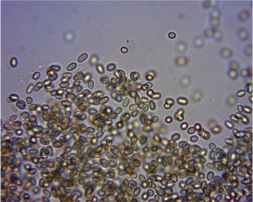Blog article #2 by Marissa McCarthy (for partial fulfillment of BESC 484 requirement)
 Diplodia is most often parasitic fungus, can be found to be saprophytic, that is extremely host specific on pine hosts or other conifer species. This Diplodia was found on a Juniper from a private residence that was submitted to the lab. Chief complaint was new growth and tip yellowing and necrosis. Diplodia is found across the vast majority of the United States including Hawaii and California, and affects most species of pine or conifer. Infected shoots become discolored and tan, often the presence of resin droplets and short needles is usually the first indication of Diplodia blight. New growth is killed quickly by fungus with repeated infection killing off whole branches back to the main stem. Continued infection without treatment can deform or eventually kill the whole tree. Fungal fruiting bodies are identified by erumpent black, single, globose, very circular pycnidia on the base of needles.
Diplodia is most often parasitic fungus, can be found to be saprophytic, that is extremely host specific on pine hosts or other conifer species. This Diplodia was found on a Juniper from a private residence that was submitted to the lab. Chief complaint was new growth and tip yellowing and necrosis. Diplodia is found across the vast majority of the United States including Hawaii and California, and affects most species of pine or conifer. Infected shoots become discolored and tan, often the presence of resin droplets and short needles is usually the first indication of Diplodia blight. New growth is killed quickly by fungus with repeated infection killing off whole branches back to the main stem. Continued infection without treatment can deform or eventually kill the whole tree. Fungal fruiting bodies are identified by erumpent black, single, globose, very circular pycnidia on the base of needles. Pycnidia can also be found erupting through the epidermis on stem tissue or on 2nd year infected cones. Conidiophores are ostiolate, slender, simple with conidia being dark, 2 celled, ellipsoid or ovoid. Spores are transparent at first formation and later become darker as they mature and are usually dispersed between March and October. Infections occur under high moisture conditions and large numbers of spores are dispersed only during rainy periods with relatively high humidity. Controls include applying fungicide to new shoots between late April and early May. Pruning or shearing should also be avoided during periods when conditions are favorable.
Pycnidia can also be found erupting through the epidermis on stem tissue or on 2nd year infected cones. Conidiophores are ostiolate, slender, simple with conidia being dark, 2 celled, ellipsoid or ovoid. Spores are transparent at first formation and later become darker as they mature and are usually dispersed between March and October. Infections occur under high moisture conditions and large numbers of spores are dispersed only during rainy periods with relatively high humidity. Controls include applying fungicide to new shoots between late April and early May. Pruning or shearing should also be avoided during periods when conditions are favorable.

Mentor comment: Watch out for syntax errors and be nice to have captions with the photos.



